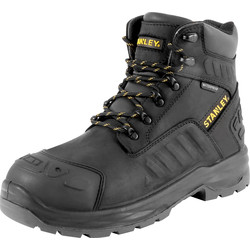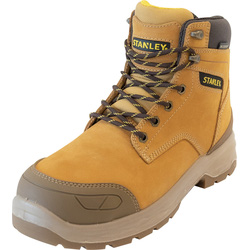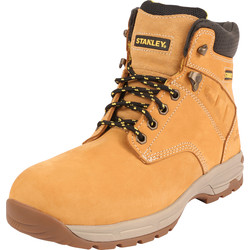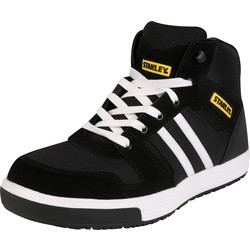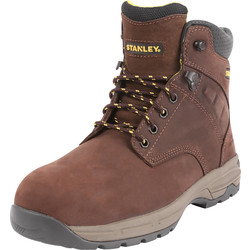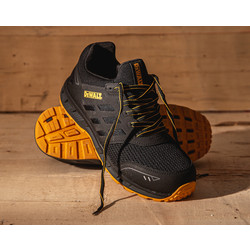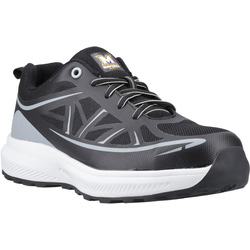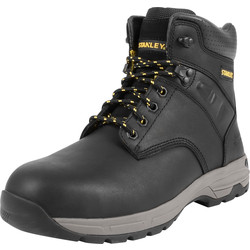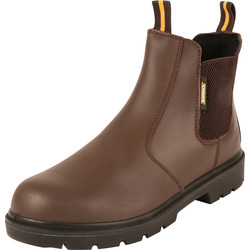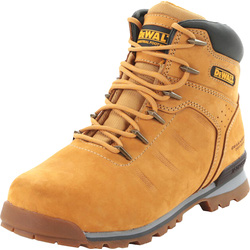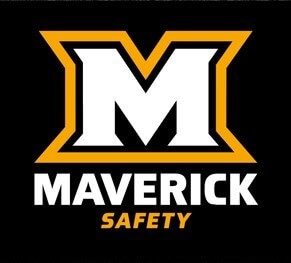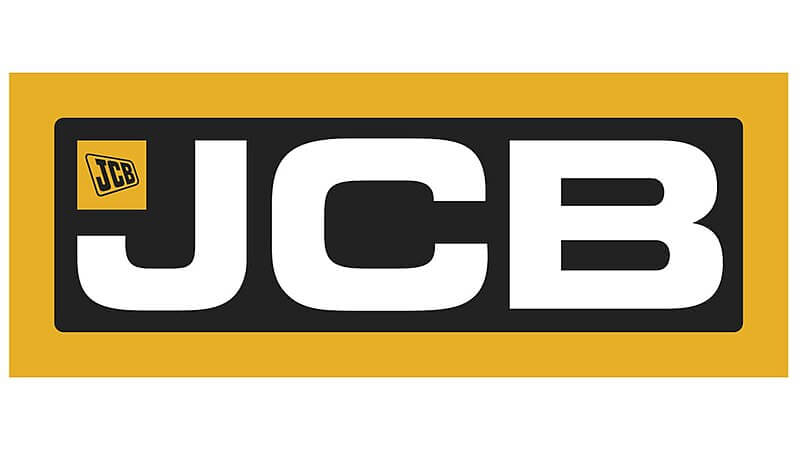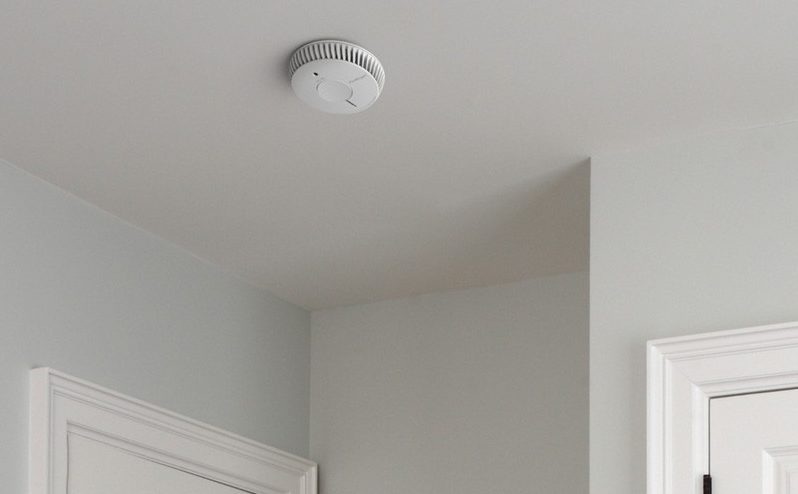Safety footwear is an incredibly important part of any tradies’ kit, and any DIYer will also benefit when carrying out many jobs at home. Every project has its risks, and the correct safety footwear can prevent potentially devastating injuries from tools and materials coming into contact with your feet.
All safety footwear in the UK must meet the requirements according to the European harmonised / designated standard EN ISO 20345:2011.
The right type of safety shoes can increase your protection whether you opt for safety boots, trainers, or wellingtons. If you're working on a construction site, you’ll have different requirements when compared to an electrician moving from house to house. Your employer may want you to wear safety boots instead of trainers for extra ankle support.
Protective toe caps are a key part of safety footwear, and you’ll want to pick the right type for the job – especially if you’ll be working with electricity. Another key aspect of safety shoes is the midsole, which can protect your feet from anything that may go into the bottom of the shoe.
Types of Safety Footwear
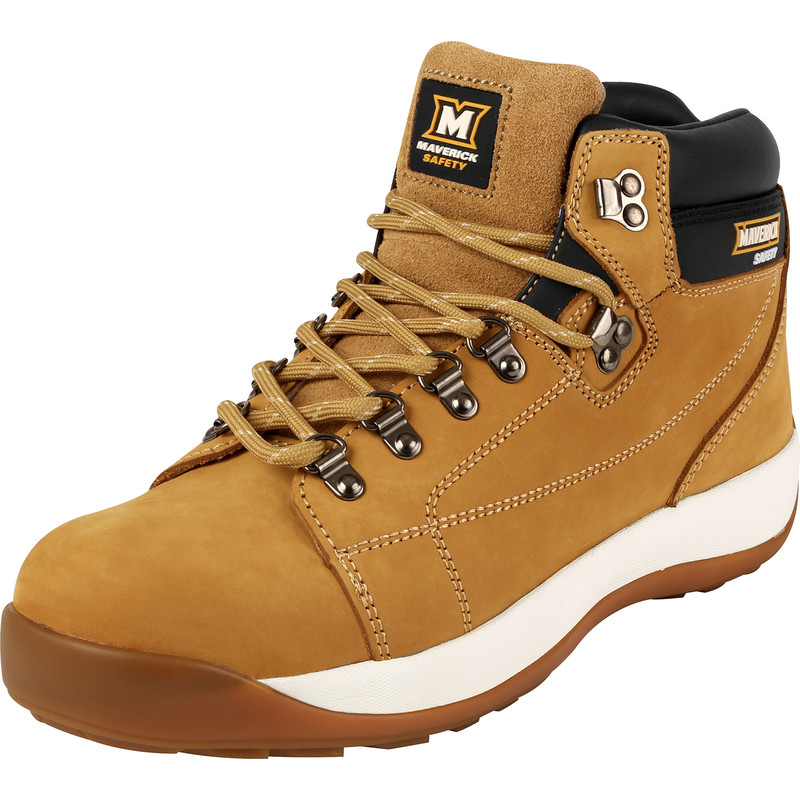
Safety Boots
Safety boots are the most common choice for a range of tradespeople. They feature protective toe caps, slip-resistant soles and, if they’re rated S1 P, S2 P, S3 or above, they’ll have a penetration resistant midsole. A durable midsole can protect your feet from anything that may stick into the shoe, like nails or screws. They also feature a high ankle, offering extra support on uneven work surfaces.
Some safety boots have a zipper on the side which makes them easy to put on and take off quickly. You’ll also find some safety boots with elasticated sides to make them even easier to slide on and off. There are also many style options available, from casual to more formal depending on your needs and personal preference.
Safety boots are heavier and bulkier than safety trainers or shoes, which could make you more tired during the day. Also, without high quality socks, they could irritate your ankle or calf. Safety boots are also harder to wipe clean than wellingtons or rigger boots, meaning they’re less suited to very wet and muddy environments.
Advantages
-
High ankle for extra support and a range of style options
-
Zippers or elastic gussets make them easier to put on & take off
-
VAT free as they’re a requirement on construction sites
Things to Consider
-
High quality socks essential to prevent ankle irritation
-
Harder to wipe clean than wellingtons & rigger boots
-
Heavier than safety shoes
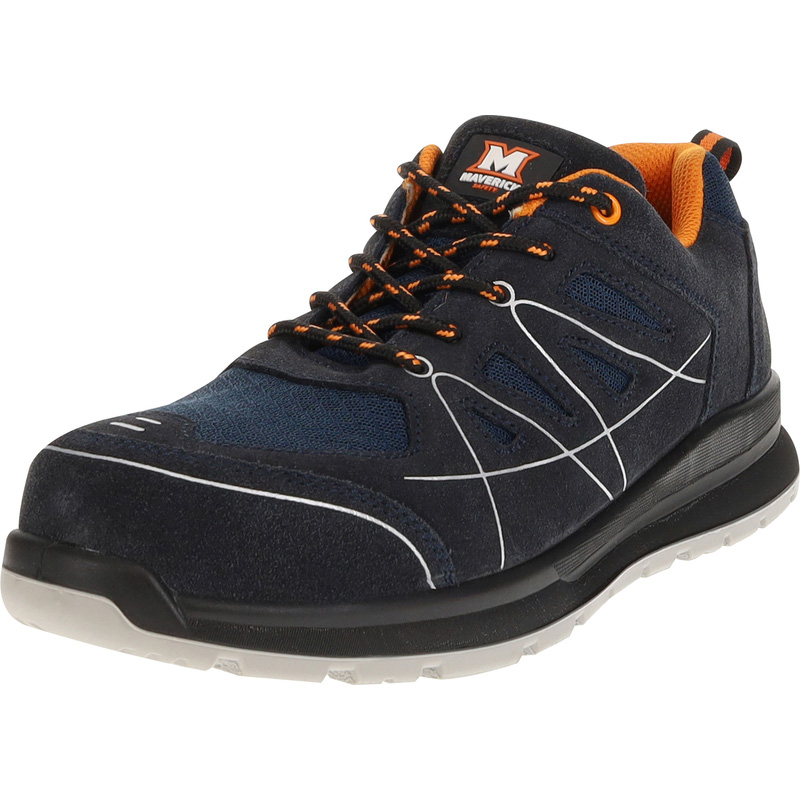
Safety Shoes & Trainers
Safety shoes and trainers are another popular choice and, like safety boots, have protective toe caps. If they’re rated S1 P, S2 P or S3 and above, they’ll have a penetration resistant midsole to protect against upturned screws or nails. They have a low ankle compared to boots, and are ideal for tradies who are after a good level of protection with a more casual appearance. They also make for a good option in the summer months when safety boots may be a bit too hot.
Safety shoes and trainers are more lightweight than safety boots, making them easier to wear for longer periods of time. They also offer a good range of movement, ideal if you carry out a lot of DIY jobs while kneeling or crouching.
This type of safety footwear offers less ankle support than safety boots, which could cause injury if you’re working on uneven ground. They're also a little harder to clean and disinfect compared to wellington boots or rigger boots, which could be a problem if you’re working on an extra-mucky project.
Advantages
-
Lightweight and ideal for the summer
-
Good range of movement
-
Casual style
Things to Consider
-
Less ankle support
-
Best suited for drier, indoor or outdoor summer jobs
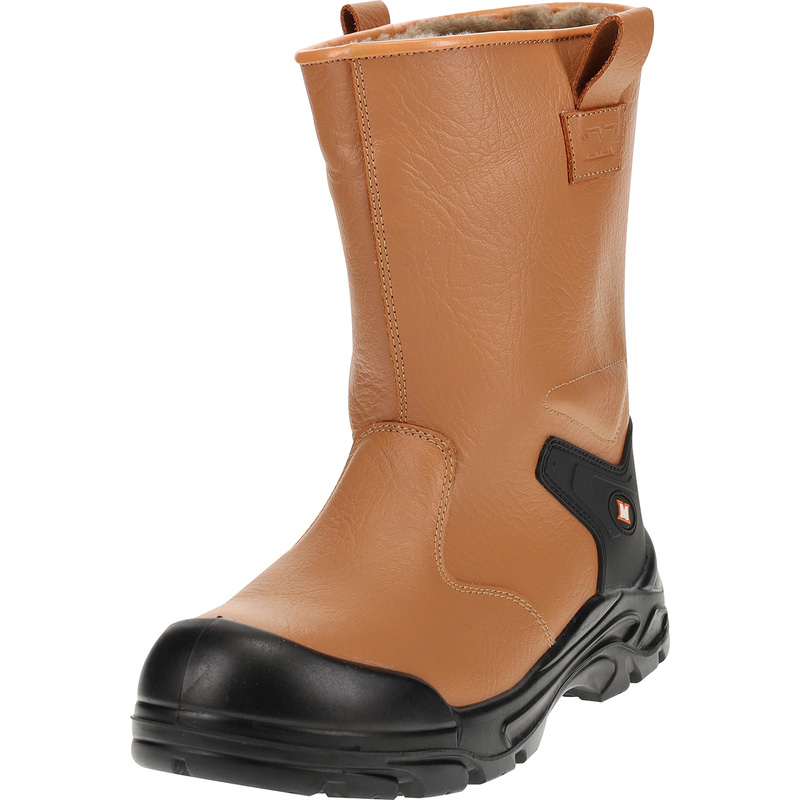
Safety Wellingtons & Rigger Boots
Safety wellingtons are made from waterproof PVC and have a penetration resistant midsole. Rigger boots offer the same higher leg protection but can be made from leather, PU or PVC and have a soft lining and padding. All have a protective toe cap and, if rated S1 P, S2 P or S3 and above, will have a penetration resistant midsole. If rated S3 or above they will also be completely waterproof. Both boots are a popular choice for tradies working with drains, waste water or in very wet and muddy conditions. This is because the material is resistant to water and very easy to clean.
You’ll find boots with a range of safety features, including a reinforced shin and heel, antistatic (which means electrical charge is sent into the ground rather than the body), as well as heat, fuel and oil resistance. The higher leg helps to ensure that any mud and water doesn't go over the top and into the boot, making them a good choice for groundworkers.
Compared to safety boots and shoes, they have less ankle support as they’re not fitted snugly, this could lead to injuries if you’re working on uneven or rocky terrains. These boots are also heavier and bulkier which could make them more difficult to move around in. You’ll also find non-safety wellingtons tend to cost less but won’t have the same features of toe caps or midsoles.
Advantages
-
Easy to wipe, spray down and disinfect
-
Pull on quickly – no laces or zippers
-
Range of safety features available depending on your needs
Things to Consider
-
Less ankle support
-
Heavier and bulkier
-
Check protection level, as you’ll find non-safety wellingtons too
Types of Toe Caps
Steel Toe Caps
Steel toe caps are a popular choice when it comes to protecting toes from tools and materials. They’re perfect for jobs that involve heavy parts, materials, and machinery such as forklifts as they’re strong and reliable.
Compared to alternative materials, they tend to cost less, making them perfect if you're on a budget or need to replace your safety boots often. Steel toe caps are found on a wide variety of safety footwear, so you’ll find the right style for you.
It's important to note that steel toe caps conduct heat and electricity so they could get a little hot in the summer months. They’re also unsafe to use if you’re working with electricity. Steel toe caps are also heavier than alternative materials, so wearing them for long periods may be tiring. They'll also set off metal detectors, which could be a problem if you’re working on high security sites.
Advantages
-
Strong and reliable
-
Low cost
-
Wide variety of styles and sizes
Things to Consider
-
Conduct heat and electricity
-
Heavier than alternatives
-
Will set off metal detectors
Composite Toe Caps
Composite toe caps are made from a variety of materials, often a mixture of kevlar, fibreglass, plastic and carbon fibre. These toe caps are formed using nanotechnology, which creates thin layers of fibre that are fused together tightly to make a thin, lightweight and ultra-strong cap.
Safety shoes with composite toe caps are especially popular for those working with electricals or in hot or cold environments as they won’t conduct heat or electricity. These toe caps also won’t set off metal detectors, which is ideal if you’re working on sites with high security measures.
Compared to steel, composite toe caps come at a higher cost which means they’re not suitable for every budget – especially if you need to replace them often. There's also less variety in terms of style and size of shoes when compared to safety footwear with steel toe caps.
Advantages
-
Thin and lightweight
-
Will not conduct heat or electricity
-
Won’t set off metal detectors
Things to Consider
-
Higher cost than classic steel toe caps
-
Less variety in terms of style and sizes
Aluminium Toe Cap
Aluminium toe caps are very similar to steel toe caps but are much more lightweight and slightly thinner, so they take up less room in the shoe. They’re used for a range of jobs that involve heavy parts or machinery, just like steel alternatives.
Aluminium toe caps make the shoes more comfortable to wear for a longer period of time because they won’t tire you out as easily.
Like steel, aluminium toe caps will conduct heat and electricity. A composite or fibreglass toe cap could be a better option if you’re working in extreme temperatures or near electricity. They’ll also set off metal detectors so consider the security measures of the sites you'll be working on. They typically carry a higher price tag compared to steel toe caps, similar to composite and fibreglass alternatives.
Advantages
-
Much lighter than steel toe caps
-
Increased comfort and mobility
Things to Consider
-
Conduct heat and electricity
-
Will set off metal detectors
-
More expensive than steel toe caps
Safety Rating Codes For Footwear
There are a wide range of safety boot ratings and each gives more information about the extra protections the shoes offer and the environment they’re best suited for. These safety boot standards indicate things such as heat resistance, water resistance, and even energy absorption.
SB safety rating
SB rated shoes refer to basic toe protection up to 200 Joules of impact and 15 kilonewtons of pressure from compression.
S1 safety rating
S1-rated shoes have the SB safety features as well as the anti-static (A), energy absorption (E), and protection from oil and petrol (FO) ratings.
S2 safety rating
S2-rated shoes have all the safety features of S1 shoes as well as a water resistant upper (WRU).
S3 safety rating
S3-rated shoes have all the safety features of S1 and S2 as well as penetration resistance (P).
S4 safety rating
S4-rated shoes have the same qualities as S1 shoes and feature a waterproof polymer upper. This rating is used for safety wellington boots.
S5 safety rating
S5-rated shoes have the same features as S4 shoes, but feature a penetration resistant midsole to protect against anything sharp that may come up through the shoe. This rating is used for safety wellington boots.
HRO safety rating
HRO rated shoes stand for heat-resistant outsole, which are made with material that has been tested up to 300℃ – these are ideal if very hot tools or materials could hit your feet.
P safety rating
Shoes with a P rating mean they’re protected from penetration by sharp objects through the midsole – with a tip up to 1100 nanometres (0.0011 millimetres).
A safety rating
Safety shoes with an A-rated safety rating have anti-static protection and electrical resistance between the foot and the ground, meaning they protect you from electric shock.
E safety rating
E-rated shoes are comfier for long periods of time, as they absorb up to 20 joules of energy. This reduces the amount of energy that goes into your joints such as your knees and ankles.
FO safety rating
FO-rated shoes means the outsoles are resistant to damage from oil and petrol, so are ideal if you come into contact with fuel on the ground as this can damage the material and reduce their effectiveness.
WR safety rating
WR stands for water resistant, so WR-rated shoes are ideal if you work in damp conditions or if you ever work outside. This rating also means the shoes are seam sealed so water can’t get through. They’ll be much more comfortable to wear as your feet won’t get wet.
WRU safety rating
WRU-rated shoes are fitted with a water resistant upper – which is any part of the shoe above the sole. This means water can’t get into the shoe from the top, making them more comfortable if water is splashed around.
SRA/SRB/SRC safety rating
SRA, SRB and SRC shoes are slip resistant. SRA shoes have been tested on wet ceramic tile with soap, SRB shoes have been tested on steel with glycerol, while SRC shoes have been tested on both surfaces.
LG safety rating
Safety shoes with an LG (ladder grip) marking will feature an abrasive sole which offers improved grip helping to prevent slips and falls.
SC safety rating
SC stands for scuff cap and this indicates that the safety footwear features a toe-cap which is more durable, and less prone to wear and tear.
Key Safety Footwear Considerations
British Standards Accreditation
All safety footwear in the UK must meet the requirements according to the European harmonised / designated standard EN ISO 20345:2011. This ensures all safety footwear sold in the UK has a minimum requirement of toe protection.
Type Of Midsole
There are two main types of midsole to choose from: steel and composite. When it comes to protection, both midsoles offer enough protection for safe working because the shoes must reach British Standards for penetration resistance. Steel midsoles are a classic choice and relatively low cost, but may be less comfortable and offer less flexibility.
Composite midsoles are made from an ultra-strong fabric which makes them more lightweight and more comfortable to wear for longer periods of time. However, they often come at a higher cost than steel midsoles. Footwear with penetration resistant midsoles will have a P rating or an S3 rating or higher.
Socks And Overshoes
Comfortable and heavy-duty socks will protect your feet, ankles and calves from irritation when wearing the same shoes for a long time. This is especially important when wearing safety boots, as the extra protection from the high ankle may rub and cause blisters.
Overshoes will protect your clients’ properties by reducing dirt tracked around the house. Plastic overshoes are disposable and easy to put on and take off between jobs – but reusable overshoes are better for the environment and can be washed or sprayed down at the end of the day. Reusable overshoes also provide grip for working indoors on tiled, smooth or hardwood surfaces.
Women's Safety Footwear
Women’s safety footwear comes in all the same types as men’s (trainers, boots, wellingtons and rigger boots) but you’ll find them in smaller sizes. They’re also made to fit women’s feet so will be narrower than men’s boots and shoes. You’ll find steel, composite, aluminium and fibreglass toe caps as well as composite and steel midsoles with the exact same level of protection for any job.
Safety footwear and work shoes for women come in a range of sizes between 2 and 9, so you’ll have no trouble finding the right one for you.


